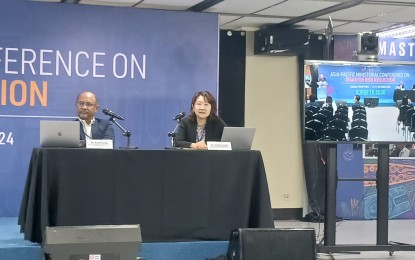
SHARING BEST PRACTICES. Dr. Rajib Shaw, chair of Environmental Design and Governance in Japan, and Ohashi Makiko, Director-in-Charge of the International Cooperation Disaster Management Bureau Cabinet Office of Japan, share their best practices in disaster risk management and rehabilitation during the Asia-Pacific Ministerial Conference on Disaster Risk Reduction at the PICC on Monday (Oct. 14, 2024). The Philippines hosts the event that aims to accelerate progress in reducing disaster risk. (PNA photo by Marita Moaje)
MANILA – Japan, a role model in disaster response and rehabilitation, shared its strategies to mitigate disaster risk at the Asia-Pacific Ministerial Conference on Disaster Risk Reduction (APMCDRR) on Monday.
Ohashi Makiko, Director-in-Charge of the International Cooperation of Disaster Management-Bureau Cabinet Office of Japan, said making people understand the frequency and the risk of disasters allows them to cooperate in the recovery process.
Ohashi said Japan continues to face challenges in its disaster risk response and is looking at other countries to improve their system.
She added that private sector cooperation is crucial especially when government effort is no longer sufficient.
“That might be applied to many other countries as well, and maybe we need to take a bit more use of private sector, civil society workforces, and maybe also digital technologies,” she explained.
One of the concrete actions that Japan is currently taking, she said, is setting up a registration system for non-government organizations and civil society groups with detailed information on their capacity and available resources.
Ohashi said civil society can be part of national response teams to supplement the government’s limited resources response.
“One sort of unique feature we are facing in Japan is, since Japan is facing a very, very rapid population aging, once disaster hits, the biggest issue is how to deal with the vulnerable populations such as seniors, because they have special needs in evacuation shelters, and they might have difficulty in rebuilding their own houses because of financial limitations,” she said.
Prolonged evacuation lines often lead to delays in the recovery process, citing the case when Japan experienced a 7.5 magnitude earthquake at the Noto Peninsula in the Ishikawa Prefecture, she said.
The earthquake caused widespread destruction, including over 60,000 damaged buildings, more than 240 deaths, and compromised infrastructure.
It also triggered a tsunami that caused extensive damage to ports and residential areas in Iida Bay.
Ohashi said high-risk countries need to make an extensive design for the early stages of recovery in the possibility of multiple disasters.
She said Japan is working on administrative changes, with focus on creating a more detailed database of vulnerable populations and the assistance needed in case disaster hits, and how to reach them in the shortest possible time.
“Then also it involves a lot of amendments of relevant laws, which are working at this moment, maybe that will last into the early next year, probably,” she said.
Still, she said that many other countries have a lot of good examples and best practices from which they could learn.
Ohashi said forums like the APMCDRR serve as the basis for making more active information sharing and mutual improvement, where countries could learn from each other.
“Still, Japan really started looking around other countries, even from Southeast Asia, European, Latin America, and pick up the good things and learn and keep on improving systems,” she said. (PNA)
